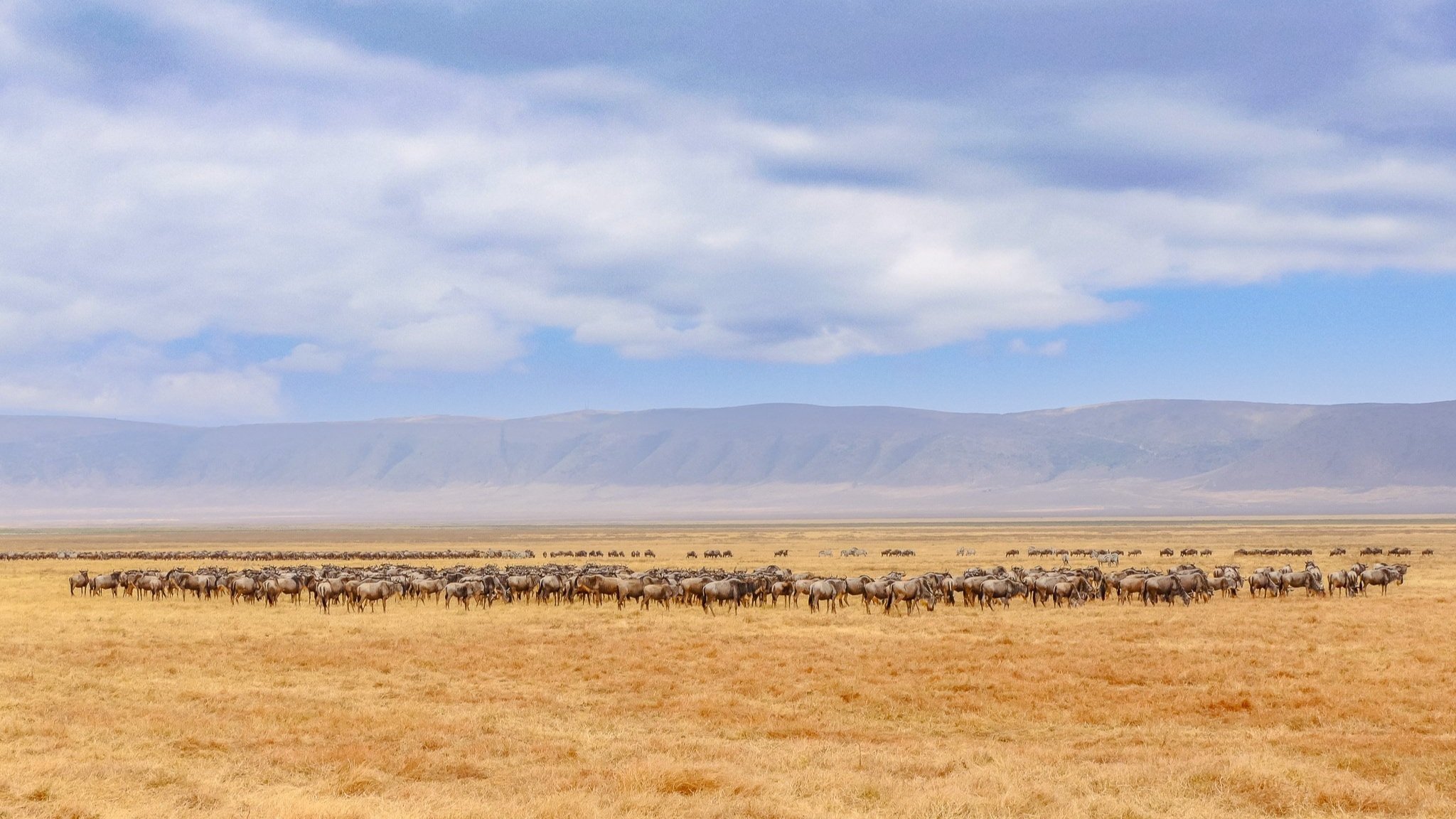
Ngorongoro Conservation Area
About
The vast open 260 sq km caldera of the Ngorongoro crater is believed to be the result of a huge volcano rivalling the size Mount Kilimanjaro (the 6th tallest mountain in the world) exploding and collapsing in on itself approximately 2 to 3 million years ago. This UNESCO World Heritage site is the largest unbroken volcanic crater in the world.
Beneath its heavily forested, 2,000-foot deep rim lies an area of unparalleled beauty, featuring open grassland savannah, lush woodlands, and a serene lake. This huge natural amphitheater is often referred to as 'Africa’s Garden of Eden', a paradise for over 25,000 diverse animals.
It is one of the few places that houses all of the Big 5 (Lions, Leopards, Rhinos, Elephants, & Buffalos) as well as a large variety of predator and prey including Hyenas, Jackals, Warthogs, Wildebeest, Zebras and Gazelles. You won't see Giraffe in the crater floor however as it is believed the sides are too steep for them to walk down. The shallow soda lakes provide a great habitat for flocks of pink Flamingos, Pelicans and other water birds whilst the area in total has about 550 bird species.
For about 200 years, the Ngorongoro crater has also been home to the Masai people and their livestock who live in harmony with the wildlife under the protection of UNESCO World Heritage Site status. It is the only conservation area in Tanzania that protects wildlife whilst allowing human habitation.
Why Visit The Ngorongoro Conservation Area?
See All of The Big 5
Ngorongoro Conservation Area, often referred to as the "African Eden," is a true wildlife wonderland and stands as one of the most exceptional places on Earth to witness the Big Five all within a single, relatively small area.
Lions: Ngorongoro boasts a thriving population of lions, making it one of the best places in Africa to witness these apex predators in their natural habitat. These majestic cats can be spotted lounging in the grasslands, patrolling their territories, or engaging in the drama of a successful hunt. Their high visibility in the crater ensures that visitors have an excellent chance of encountering them, often at remarkably close range.
Leopards: While leopards tend to be more elusive than lions, Ngorongoro's varied terrain, including forests and riverine areas, offers suitable habitats for these secretive cats. Patient visitors may be rewarded with a glimpse of a leopard draped across a tree branch or stealthily stalking its prey.
Elephants: Ngorongoro Conservation Area is home to a notable population of elephants, and you can often spot these gentle giants roaming the crater's lush forests and grasslands. Observing elephants in this setting is a captivating experience, especially during the dry season when they gather around water sources.
Rhinoceroses: While sightings of these endangered creatures are not guaranteed, the conservation efforts in the area have led to a slowly growing population, making the possibility of encountering rhinos increasingly promising.
Buffaloes: Cape buffalo, often called the "African buffalo," are also present in Ngorongoro. These formidable creatures graze the grassy plains and offer an additional component to the Big Five ensemble.
Lions Lions Lions
Ngorongoro Conservation Area boasts an extraordinary claim to fame – it is home to one of the densest populations of lions in the world. The fertile crater floor, abundant prey species, and a well-managed ecosystem have created the perfect conditions for lions to thrive. The Ngorongoro lions are known for their impressive numbers and relatively high visibility. It's not uncommon to encounter prides of lions during a single safari drive. Whether you witness these majestic cats lounging in the sun, socializing with their pride members, or engaged in a thrilling hunt, the density of lion sightings in Ngorongoro provides a truly unparalleled safari experience for wildlife enthusiasts and photographers.
A Natural Wonder of Africa
Ngorongoro Conservation Area is not only renowned for its remarkable wildlife but also stands as a natural wonder of Africa. At the heart of this extraordinary landscape lies the Ngorongoro Crater, a massive volcanic caldera formed millions of years ago. This unique geological feature is a sight to behold, with its sheer walls encircling a lush, green expanse. The Ngorongoro Crater's beauty lies in its contrasts – from the grassy plains where wildlife roams to the soda lakes where flamingos gather, and from the dense forests that shelter elephants to the open savannahs where lions reign supreme. The stunning backdrop of the crater adds an extra layer of enchantment to every safari experience within the conservation area.
When is Best to Visit The Ngorongoro Conservation Area?
-
This is the short dry season . Daytime temperatures range from 20°C to 25°C (68°F to 77°F), with cooler nights. The landscapes are still lush from the recent rains. Wildlife is abundant, and The Big Five can still be spotted, and it's a great time for birdwatching as migratory birds return to the area.
-
This is the Long Rains Season and the wettest time of the year, with consistent rainfall. Daytime temperatures ranging from 15°C to 20°C (59°F to 68°F) and cooler nights. Wildlife viewing is still possible but more challenging due to the dense vegetation.
-
This is the dry season. The temperatures are pleasant, with daytime highs from 20°C to 25°C (68°F to 77°F) and cooler nights . This is the best time for wildlife viewing as visibility is excellent due to the lack of vegetation making wildlife spotting easier.
-
This is the short rains season. Temperatures are comfortable, with daytime highs from 20°C to 25°C (68°F to 77°F) and cooler nights. Witness greener grasslands a more vibrant scenery. Wildlife remains abundant, with the Big Five still being present, but slightly more more dispersed.
Need More Inspiration?










